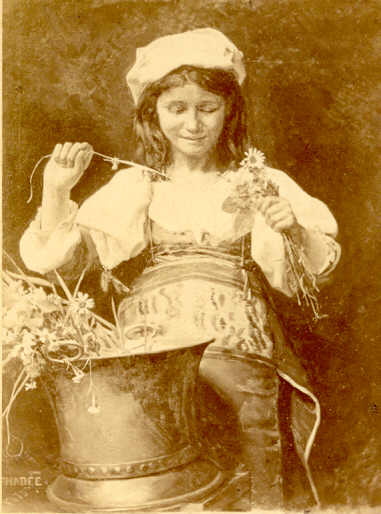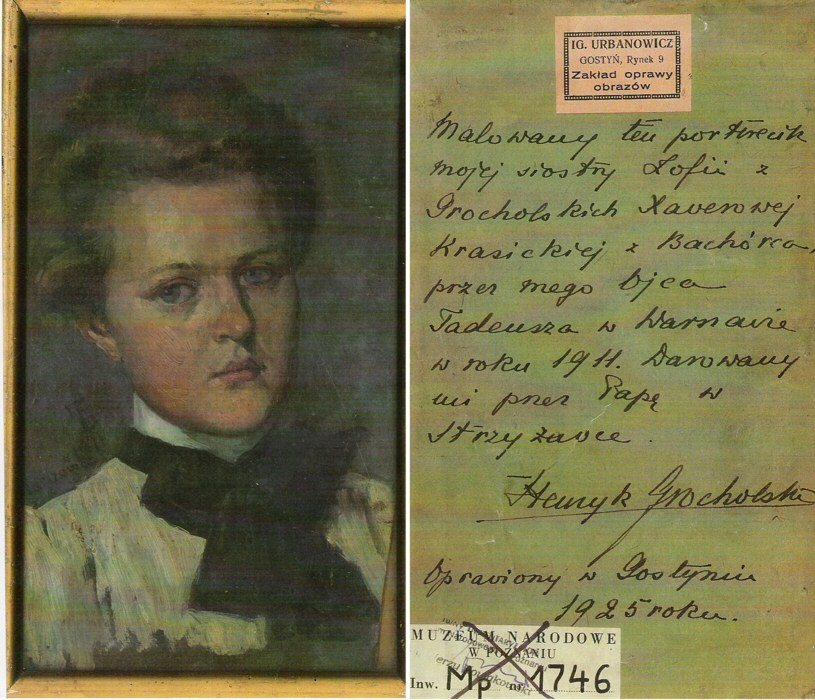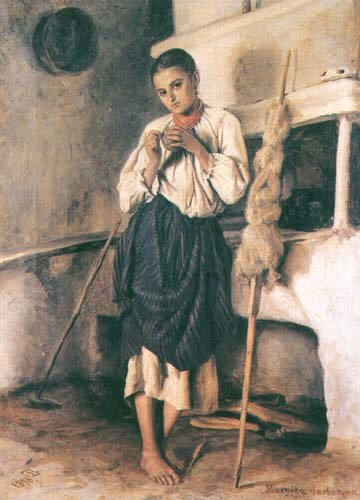Grocholski Tadeusz Przemysław Michał (1839-1913), painter, landowner. Born on May 3 in Pietniczany in the Vinnytsia district as the son of Henryk and Ksawery from the Brzozowski family. After completing the cadet school of the guard in St. Petersburg, he became a lieutenant of the horse guards. Released in 1859, he went to Paris to study painting under the famous portraitist J. Bonnat, and then to Madrid, Munich, Vienna, and finally to Krakow where he became close to Matejko and J. Kossak. After his father’s death in 1866, he managed the inherited estates in Podolia, expanding them by acquiring the family, and threatened with sale to foreign hands, the Strzyżawka estate. He was the vice-president of the Podolian Agricultural Society in Vinnytsia, along with his brother Stanisław, organized agricultural exhibitions, a peasant bank, etc. At the same time, he painted a lot, especially local types, religious paintings, portraits (including the portrait of Władysław Czartoryski), participated in the years 1881-1901 in the exhibitions of the Society of Fine Arts in Krakow, and at the Polish painting exhibition in Lviv, he received a silver medal in 1894. He also exhibited in Paris and the Warsaw Zachęta. Together with Iza Działyńska, he painted frescoes in Gołuchów. Grocholski gave significant support to Kazimierz Pochwalski in his early studies, traveled with him to Paris. He also sent a peasant from his estate, Jan Zasiedatel, to study in Rome at his own expense. He was married to Zofia Zamoyska, daughter of Stanisław from Podzamcze. He died on July 16, 1913, in Strzyżawka.
“Polish Biographical Dictionary” volume VIII National Institute Ossolińskich, PAN Publishing House Wrocław – Krakow – Warsaw, 1959-1960
author Karol Rolle, pp. 589-590
“Grocholski Tadeusz Przemysław Michał, painter, born May 3, 1839, Pietniczany, Vinnytsia district, died July 16, 1913, Strzyżawka on the Boh, son of Henryk and Ksawery from the Brzozowski family; married in 1886 to Zofia Zamoyska.
In 1859 he graduated from the cadet school of the guard in St. Petersburg with the rank of lieutenant. In 1860 he went to Paris. In the autumn of that year, he stayed with his older sister Maryna Czartoryska in Biarritz, where they both drew sea views and characteristic portrait studies. They then traveled around Spain. In May 1861, Grocholski returned to the country. In 1864 he went to his father in Odessa, where he stayed intermittently until about 1870. During this time he traveled with Maryna Czartoryska (after the death of her husband Witold, died 1865) through Egypt, Turkey; they were also in Beirut. He then settled in his estates in Podolia. He was involved in managing the estates (Pietniczany, Strzyżawka), social activities (he was vice-president of the Podolian Agricultural Society in Vinnytsia, organized agricultural exhibitions, a peasant bank with his brother Stanisław). He helped Kazimierz Pochwalski, with whom he traveled to Paris; he sent a peasant from his estates, Jan Zasiedatel, to study painting in Rome at his own expense.
According to the artist’s daughter Anna Grocholska, Grocholski privately learned drawing during his stay in St. Petersburg, studied painting under J. Bonnat in Paris, J. Matejko in Krakow, and C. Griepenkerl in Vienna. The earliest known works of Grocholski date back to 1858. These are portraits, five pencil drawings, and one watercolor (National Library in Warsaw), two of which, created in Odessa, depict local drawing teachers: Kochler and Fr. Mahlmann. He painted types, portraits, e.g., of his wife, children, brother Stanisław, sister Helena Brzozowska, Mikołaj Grocholski (the portrait was in the sacristy of the church in Strzyżawka) Władysław Czartoryski, Artur Russanowski, and a self-portrait (the last two are private property in Warsaw).
The sketchbook from the National Library contains a series of portraits of landowners and aristocracy, including Jan Działyński, 1858, and Antoni Potocki, 1864, as well as types such as: Warwarka, Paraska, Kateryna Pańka, all signed, 1871.
He was the author of religious paintings, e.g., Christ for the church in Strzyżawka. He copied many, including Titian’s Mater Dolorosa, Murillo’s Saint John (during his stay in Spain), as well as Bonnat’s Christ – four paintings on metal, which were placed on crosses erected in Grocholski’s estates in Podolia: in Strzyżawka, Kniaży, and Kupin. He also made wall paintings in the palace in Pietniczany in the Arabic and heraldic rooms, adorned – together with Iza Działyńska – with Arabic inscriptions one of the rooms of the castle in Gołuchów. (Grocholski’s drawing depicting a view of the castle in Gołuchów, with both figures, has been preserved in an album in the National Library.)
Around 1874 he painted a stained glass window of the Black Madonna of Częstochowa in the Carmelite convent in Poznań. He did this together with his sister Maryna, then a nun in this convent. In an album from the National Library, there is a humorous word-and-drawing story (12 drawings by Grocholski pen ink, 1874), depicting the artist’s trip to the market for fish for the convent.
Grocholski exhibited in the years 1875-1878 and 1888, at the Society of Friends of Fine Arts in Krakow (including Italian Flower Girl, Study of an Italian Woman, Ruthenian Woman, Maryjka Harbarówna, Podolanka. Portrait of Marquis Wielopolski, crayon drawing).
Works:
National Museum in Krakow – Portrait of Prince Ogiński, oil 1882
Czartoryski Department – album of sketches, pencil, crayon, and ink drawings;
Museum of Romanticism in Opinogóra, in an album containing works by various artists – Girl in Folk Costume, watercolor, Girl, pencil, both signed TG (intertwined monogram), 1871, Bust of a Girl in Folk Costume (gypsy?), watercolor. National Museum in Poznań – Portrait of Zofia from Grocholski Krasicka, oil on wood, signed, 1911
Museum in Tarnów – Portrait of Roman Adam Sanguszko, oil, signed: “T. Grocholski (1875) Sławuta”
National Library in Warsaw – sketchbook with 34 pencil drawings from the years around 1858-1971 and an album containing his 18 ink, pencil, and crayon drawings from the years 1874-1875 (there are also 14 drawings by Maryna Czartoryska), in both some signed TG (intertwined monogram); at Anna Grocholska in Warsaw – her portrait as a child, oil 1912. In the collections of T. Litawiński in Zakopane – Head, oil, Hermit in a Cave, oil.
Bibliography:
Memoirs of Xawey from Brzozowski Grocholska, ed. Feliński Z.S., Krakow 1895, pp. 280, 393, 486, 512, 577, 582, 586, 597, 598, 602, 614, 633, 645, 656, 718, 725, 732, 741, 746, 751, 778, 824, 826, 827, 828, 829, 861, 868, 875, 903.
Boniecki A. Polish Heraldry, vol. VII, 1904, pp. 67-68.
Swieykowski E., Memoirs of the Society of Friends of Fine Arts in Krakow, Krakow 1905, pp. 87-88 (mixed information about Tadeusz and Stanisław Grocholski)
Uruski S. Family. Polish Nobility Heraldry, vol. IV, 1907, p. 380.
“Illustrated Weekly”, 1927, half-year II, p. 737
Urbański A., From the Black Trail…, 2nd ed., Warsaw 1928, pp. 66, 70
Exhibition of 19th-century Polish painting from the collections of Tadeusz Litawiński, Zakopane 1957 (with dates of Stanisław Grocholski’s life)
Polish Biographical Dictionary, vol. VIII, 1959-1960 (note K. Rolle)”
Biographical note of Tadeusz Grocholski “Dictionary of Polish Artists” volume IV year 1975, authored by J. Białynicka-Birula
GROCHOLSKI Tadeusz Przemysław Michał (1839-1913) – painter and graphic artist, social activist. Born on May 3 in Piatnyczany, Vinnytsia district. He was the son of Henryk and → Ksawery from the Brzozowski family, brother of → Stanisław and → Maria Czartoryska. He graduated from the cadet school in St. Petersburg (1859), became a lieutenant of the horse guards. Released from service, he went in 1860 to study painting in Paris, where he studied under the famous portraitist L. Bonnat. In the autumn of the same year, with his sister Maria, he painted sea views and portrait sketches in Biarritz. They then traveled around Spain. In addition, G. visited Rome, Munich, Vienna, and finally Krakow, where he befriended J. Matejko and → J. Kossak. Accompanying him in training was a talented young man, a peasant from the estates of Z. Brzozowski, І. Sokołenko, later known as the portraitist J. Zasidatel. G. sincerely took care of him and introduced him to the workshops of famous painters. These journeys so shaped both debutants that after returning to Paris, both received recognition from Bonnat. G. also financially supported his friend K. Pochwalski in his early painting studies.
In May 1861, G. returned home, in 1864 joined his father in Odessa, where he stayed intermittently for almost 6 years. With his sister Maria, he traveled through Egypt and Turkey, visited Beirut. He then settled in his Podolian estates. According to the terms of the family division of paternal inheritance (1892), he received Kniażopol, Kniaża, Kośnica, Antonówka, Ternowka small (Ternowka), Kajetanówka, and Andryaszówka Vinnytsia district, Gubcze, Partyńce, and Kupyn Zasław district. Around 1880, he acquired in the Vinnytsia district the Stryżakiwski estate (Stryżawka, Slobodka-Stryżawska, Ławrówka, Dębowa, and Pereorki), the family estate of the Grocholski, which was threatened with sale to foreign hands after the death of Mikołaj Grocholski. The owner of the estate, J. Morawski, who lived abroad, first transferred to him the power of attorney to manage the estate (certified in the Department of Internal Affairs of the Ministry of Foreign Affairs in May 1879). According to the then law, only a Russian could buy the estate, but G. paid off all the debts with which the estate was burdened, securing the invested capital with a mortgage agreement and a 16-year lease in the contract, which in fact was a purchase. In addition, he rented from Morawski’s sister Maria Salnik of the same district (1880–88). Between 1905 and 1911, he acquired Izabeliwka Vinnytsia district. In Pereorki and Kniaże, he had distilleries.
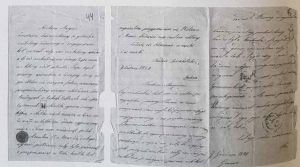
The Stryżawka estate at the time of purchase was in a deplorable state — both agriculture and the palace in Stryżawka. The tsarist palace was rented by the government for a hospital for prisoners arriving from the Russo-Turkish war. Soon a Turkish cemetery was established in Stryżawka, separated by G.’s efforts with a deep moat, planted with trees, and adorned with a white marble monument with an appropriate inscription in Turkish, topped with a crescent with a star. Sultan Abdul-Hamid II, upon learning of this, sent him the Medjidie Order 1st class with a ribbon. Rebuilding the Stryżakiwski palace and farm, G. had to simultaneously fight with the previous owner, who began to demand additional payment, and with Russian officials who tried to take the property into their own hands. Winning this battle was helped by a petition to the tsar submitted by a friend from youth, Russian minister bar. W. Federiks.
He also devoted a lot of time to social activities. Together with his brother Stanisław, he founded in Vinnytsia in 1880 the I savings and loan association (the so-called Peasant Bank). He was the vice-president of the Vinnytsia branch of the Podolian Agricultural Consortium. He participated in the congress of landowners of the Podolian governorate on August 28-31, 1896, in Proskuriv, where he was elected a member of the congress council. He actively worked in PSGR, among others as a colleague of the chairman (1898-1908) and treasurer (1898-1905). In 1908-09 he served as trustee of the practical school of horticulture and agriculture in Humennomu Vinnytsia district. For many years of fruitful work, he was elected in 1908 as an honorary member of PSGR. He was elected several times as a juror in the Vinnytsia district, legitimized with his brother Stanisław in 1881 in the Podolian governorate and received confirmation of the title of count.

Self-portrait*.
G.’s artistic legacy includes religious canvases (in particular, for the Strzyżawka church he wrote the painting “Christ”), self-portrait, portraits (including R. A. Sanguszko (1875), W. Czartoryski, A. Rusanowski), members of his family (including daughter Zofia (1911), Mikołaj Grocholski, brother Stanisław, sister Helena, wife), local peasants (including “Warwarka,” “Kteryna Pan`ka,” “Paraska,” “Girl in Folk Costume” (all 1871), “Ukrainian Woman,” “Peasant Woman” (1880s), “Podolian Woman,” “Ruthenian Woman”). He copied masterpieces of European painting, including Titian’s “Mater Dolorosa,” Murillo’s “Saint John” (during his stay in Spain), Bonnat’s “Christ” (4 paintings on metal were placed on crosses installed in Strzyżawka, Kniażomu, and Kupyni). He devoted a lot of time to arranging the family chapel-mausoleum near Strzyżawka, in particular, he ordered an altar for it in Odessa according to his own sketch. He painted the walls in the so-called “heraldic” room of the Pietniczany palace of his brother Stanisław. In Gołuchów, Pleszew district, together with I. Dzialińska, he decorated one of the rooms of the castle with Arabic inscriptions and painted frescoes. Around 1874, together with his sister Maria, he decorated the stained glass window of the Black Madonna of Częstochowa in the Poznań Carmelite convent. He participated in the years 1881-1901 in the art association fairs in Krakow, and at the Polish painting exhibition in Lviv in 1894, he received a silver medal. He exhibited his works in Paris and Warsaw (in the association for the promotion of art).
He died on July 16, 1913, in Strzyżawka. Buried in the family chapel-mausoleum near Strzyżawka (on the river. Southern Bug). In the State Archive of the Volyn Region (ДАВО) are preserved letters of G. to members of his family**. G. was married (marriage on August 30, 1886, in Warsaw) to Zofia Zamoyska (1865 (1866?) -1957), daughter of Stanisław and Róża from the Potocki family, with whom he had children: Tadeusz (May 22, 1887-July 6, 1920), graduate of the Alexandrian General Lyceum in St. Petersburg (1908), member of the “Podolian Association of Agricultural Farms” (from 1914 its treasurer), member of the Union of Polish Landowners of Podolian Province and founding member of the Cooperative Association on Faith in the Union of Polish Landowners of Podolian Province (so-called “Polkopodol”-«Полькоподоль», statute approved on September 28, 1918′), married to Zofia Rusanowska, → Remigiusz, Zofia (October 6, 1889-August 8, 1969, Krakow), married to Ksawery Krasicki, Michał (November 17, 1891, Strzyżawka – January 18, 1924, Plianta), married to Maria Józefa Czetwertyńska, Anna (October 6, 1892, Strzyżawka), Stanisław (June 25, 1894, Strzyżawka – January 12, 1895, there), Henryk (March 17, 1896-1931), Ksawery (November 1, 1903, Strzyżawka – 1947, Warsaw), married to Katarzyna Stangierska, graduate of the Antwerp Trade Academy and the Faculty of Law of the Brussels University, participant in the Warsaw Uprising (1944), from 1945 member of the underground organization “Freedom and Independence”, arrested on November 14, 1946, on charges of belonging to it and espionage, was executed on November 24, 1947, in Mokotów prison, cleared of charges on March 8, 1991.
G.’s son Tadeusz during the revolution managed to transport several valuable collections, including family portraits, from the Stryżawka palace to Vinnytsia, where they entered the regional museum. Only the library and a valuable collection of prints were stolen along the way. On January 18, 1918, the palace in Strzyżawka was plundered and then burned, on the same day the family tomb near the Bug was devastated. In 1920, G.’s son Henryk during the Polish Army’s Kyiv expedition took the family’s property from the regional museum in Vinnytsia and transported it to Warsaw, where all the collections perished during the Warsaw Uprising (1944).
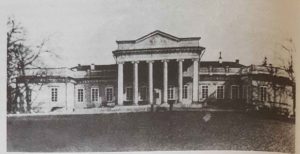
Enc. org. (Supplement); PSB (K. Rolle); SAP (J. Białynicka-Birula; Geographical Dictionary (Pietnicany, Strzyżawka): *Aftanazy, vol. 10, pp. 395, 397, 404-409, 411–416 (409*); Boniecki, vol. VII, p. 68; Drwęca [Radzi¬miński Z.] Pietniczany and their Heirs, Cr., 1878, p. 7; Sobańska, pp. 2, 24, 27, 63, 65, 70. 73, 89. 139, 187, 198 (p. 96); Urbański (1), pp. 66, 70; Uruski, vol. IV, p. 380; — Grocholski Ksawery // www.grocholski.pl.pl/biographies.php?strona=6; – МУ; AK, 1900, e. 82, 23.1 236; AK, 1904, c. 84, 240, 242; AK, 1909, c. 94, 277, 280; AK CO, c. 57; Lists for the entire Podol. province, [pag. 301, e. 2, [pag. 37], c. 1, [nar. 71], с. І; List of nobles of Podol. province, p. 165; ІІамятная книжка лицеистов Императорского Александровского лицея (1811-1911), (СПб., 1911, p. 79; Works of PEISK, p. 775; Works of the first congress of village owners, pp. 7, 11, 25, 97-98; Guldman, pp. 376, 708, 714; Krylov, І. 207-210; Malakov (1), pp. 42-43; Reference, letter, 1909, No. 5/6, p. 22; Historical reference //Podol. farm, 1915, No. 9/10, p. 2; Same, p. З; –ДАВО: f. 174, op. З, file 4434; f. 200, op. 1, file 131, fol. 81, file 691. fol. 38 *.-39Я зв-96, 206; f. 233, op. І file 137; f, 271, op. 2, file 8, fol. 120-122 зв, 159 зв.-160, file 9, fol. 44-44 зв., 112-113, 121-122, 125 зв.-126; f. 470, op. З, file 20а, fol. 251-252 зв.; **f. 866. op. 1, file 4, 8, 9, 46; f. 904, op. 4, file 9, fol. 131-134, file 12, fol.248 зв.-249,file 13,fol.260 зв.-261, file 15, fol. 139зв.-140,file 16, fol. 86, file 17, fol. 272 зв.-273; f. 904, op. 11, file 5, fol. 274 зв.-275. file 63, fol. 142 зв-143, file 68,fol. 34зв.–35.
The biography comes from the book FAMOUS POLES IN THE HISTORY OF VINNYTSIA by Mrs. Wiktoria Kolesnyk.
Posthumous Remembrance of the Late Count Tadeusz Grocholski son of Count Henryk and Xawery Brzozowska
Kiev Journal from August 14, 1913
General recognition, peace in wide circles of fellow citizens is primarily gained by the content of one’s own life; work aimed at social good, character, however, certain external forms of character and disposition are not without significance, which often lead the wider public to not entirely fair assessment of a person, often only a very close acquaintance, which can only be given either by continuous contact in everyday life, or longer companionship in some joint work allows to fully appreciate the true qualities of mind and heart, the true value and merits of the one with whom one lives or works.
I write these words with the thought of the late Tadeusz Count Grocholski. His death not only orphaned the family of the deceased; it also caused a significant loss to our entire society, it loses in the late Tadeusz Count Grocholski a deserving citizen, a worker of such a measure that is not easy to match. And the greater the difficulty in replacing what is lost, the more painful the loss, the more grievous the mourning.
Moral strength, principles giving direction in life and protecting from deviating from the path of virtue and duty, is primarily given by upbringing, the influence of the Family, both in the earliest years of life, in childhood, and in school, youthful years.
Tadeusz Grocholski was deprived of this second part of influence; at the age of 15, still a child, he was taken to St. Petersburg and placed in the Cadet School, he found himself in an environment that could have influenced him quite differently.
Later, military service, after it long years spent abroad. Having a great talent for drawing and painting, he worked in this direction, thus artistic life, travels. In the country, he was only a guest. The older brother managed the estate, so the affairs of the farm on his own land did not require more frequent presence in the country. And yet, even such a test was withstood by the sense of duty, attachment to our land.
Marrying Countess Zofia Zamoyska in 1886, he settled on this land and from that time on devoted all his abilities, his time, and energy in the country and for the country.
And he had rare energy: long-term efforts to maintain a significant part of the estate, seized by people of ill will, and these sad circumstances that our country is experiencing and experiencing did not break it. Internal concern was always covered by never-ending cheerfulness and humor and that natural freedom and clarity of thought, which only one who acts according to the principle best expressed in the French proverb “Fais ce que doit, advienne que pourra” can have.
Relations and acquaintances acquired in youth Tadeusz Grocholski skillfully used to do good wherever possible. A faithful son of the Church, he spared no efforts primarily in defense of its oppressed rights, and several of our churches owe their existence to him today.
When the Podolian Agricultural Society was initiated and it was about taking on the duties of vice-president, Tadeusz Grocholski, older than the one who was to lead the Society (“because only a Russian could be president. They appointed Count Heyden, a former colonel” – note Zofia Countess Grocholska), agreed to work in this position, although not one in his place might not without reason find it inappropriate to be second there, where merit, age, and authority gave every right to precedence. But as always, here too the guiding thought was not self-love, but the desire to bring benefits to the general cause, regardless of one’s own person. Self-love, ambition, and the pursuit of official honors and titles many wanted to find in Tadeusz Grocholski’s conduct and activity. The rank of Equerry of His Imperial Majesty’s Court received by him seemed to be water on the mill of those who thought so. Such judgments were completely wrong; stones in our society are easily thrown, but they also easily resort to stoning when only their influence and significance can achieve something for this society. Appearances are deceptive, and such appearances were primarily provided by the disposition, the way of behavior of the Deceased. Cheerfulness in the most unpleasant moments of life never left him, seasoned with a fair dose of irony, which not everyone could recognize. Categorical, without reservations, expressing one’s opinion, in a way perhaps too harsh and not counting with the general opinion could alienate many. Temporary popularity may lose on this, but it does not bring any harm to the inner value of a person.
Tadeusz Grocholski sought no popularity; he did what he considered his duty as perfectly as possible, most thoroughly, and with perseverance and systematicity worthy of admiration and imitation.
If we had more such people in the country, keeping their accounts so strictly, providing so much to others, needing so little for themselves, and living so modestly despite considerable fortune, things would be better for us and our state of possession, the main foundation of our existence here, would not be as endangered as it is now due to our own fault.
Tadeusz Grocholski, with foresight and skillful administration of inherited estates, not only increased the land but also devoted much effort to the general issue of our possession and agriculture, developing fair foundations for the abolition of the checkerboard of citizen and peasant lands, to carry out separate. The lack of separation is one of the main reasons for the continuous hindrance of the normal development of agriculture in the Podolian land.
In this conviction, the Deceased thoroughly examined these matters, with his characteristic accuracy, and was rightly regarded as the best expert in the country in this direction. As such, he was summoned to St. Petersburg, where he spent months, taking an active and lively part in the work of special commissions established by the Government for this purpose, and if we finally witness the organization of this so important “Agrarian Issue” for us, to a large extent, we will owe it to Tadeusz Grocholski.
Many more could be written about him, but prudence dictates silence about some things. In the sad conditions of our life in the Borderlands, silence must often be more eloquent than words.
Modesty, avoiding publicity also showed in the last will of the Deceased: he wished for the simplest funeral, did not want notices of his death to be sent, did not desire to be written about. The will of the deceased should be law for the living; but on the other hand, a fair assessment of deserving people, gratitude to them, and paying them due tribute for all they have done for society, is a sacred obligation and right for society, gratitude ennobles, strengthens, highlighting a good example gives… many to follow it.
We therefore believe and hope that these few words of remembrance dedicated to a deserving fellow citizen, the Family of the Deceased will not consider a violation of his will, but will wish to regard them as proof of true recognition and gratitude, as an expression of hope that the Sons of such a Father, striving to match him and following his path, will work as usefully and fruitfully for the Country as he did, and finally, as an expression of the most sincere sorrow, dedicated to the late Deceased, which our society, through the writer, lays on the grave of the irreparable and one of the most faithful Sons of our Homeland,
Fellow citizen.
Jan Narkiewicz Jodko
